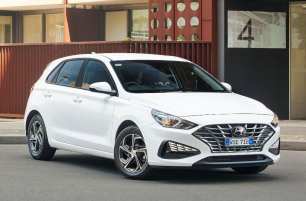The GR Corolla isn’t as engaging to drive as the GR Yaris, it’s not as honed as one particular rival, the Honda Civic Type R, and it’s not as ‘nice’ as the Golf R.
But the GR Corolla is still an excellent car to drive, and it’s better for its update. In fact, the two major gripes I had with the pre-facelift car have been addressed.
I was in a unique position to be able to compare the old and new versions of the GR Corolla as I drove a MY 2024 version a week prior to the media launch for the 2025 model.
The first and probably biggest issue I had was that the Corolla’s suspension seemed like it must have been rather stiff and the body bracing quite rigid for a car riding on 19-inch wheels to let that much road noise and that many harsh bumps into the cabin.
Though it wasn’t mentioned before the on-road drive loop, the car felt more compliant without sacrificing ability and seemed much more suited to daily duties.
Toyota’s product team confirmed there had been tweaks made to the rear suspension geometry and that I wasn’t just imagining it.
The second issue is more for the sake of passengers who may be less agreeable to the three-pot thrum resonating along the exhaust underfloor.
Toyota has solved this by putting a slight mute on the pipes in the Eco drive mode, so the car is now just ‘a bit’ lairy rather than full boy racer.
Generally, it’s hard not to compare the GR Corolla to the smaller (but original) GR hatch, the Yaris. Especially having driven them back-to-back at the media launch.
Without leaning too much on that, I will say that while the Yaris feels like a rally car that's been modified to be road-legal, the Corolla feels more like a road car that was tweaked for rallying.
The Corolla stops just short of being too ‘raw’ for everyday use in most aspects, but it’s still very capable when it comes to driving fast.
Like its suspension, the steering feel is dialled in for feedback without being too rough, and allows you to corner accurately without feeling like you need to second-guess or adjust inputs.
When it comes to handling, it doesn’t feel like the Corolla is entirely leaning on the Yokohama Advan tyres for grip, as it feels tied-down and doesn’t pitch and roll through corners.
The duality of the GR Corolla is helped by its drive mode and differential settings and even on track can help you lean into your own driving style.
While the rear-biased 30:70 setting previously made for a slightly tail-happy hot hatch, the new variable Track setting does a fabulous job of keeping the drive where it needs to be, though it turns out it’s also rather handy for sliding the Corolla around a wet skid pan.
Another neat trick is the GR’s handbrake, same as the Yaris, which can disconnect the rear diff when engaged so you don’t need to dip the clutch pedal in the manual version when indulging in handbrake turns.
It will set you back to 2WD mode when the drivetrain overheats, however, or at least when its sensors suspect the drivetrain has overheated - something that only happened after a lot of handbrake turning and spinning wheels as the hatchback slid sideways.
The Corolla’s brakes are ventilated 356mm front and 297mm rear discs, and doesn't lose stopping power even after plenty of tight, twisting road driving where the brakes and the sticky Yokohama Advan tyres copped a workout.
The new auto transmission is also a delight. It's calm during normal driving but snappy with shifts in Sport mode and set to manual gear selection. It won’t really cooperate on a rapid drive of its own accord.
The only criticism of the auto gearbox (aside from being less engaging than the manual, but that’s your own choice) is that the shift paddles behind the wheel feel a little plasticky, but I’m nitpicking at this point.

